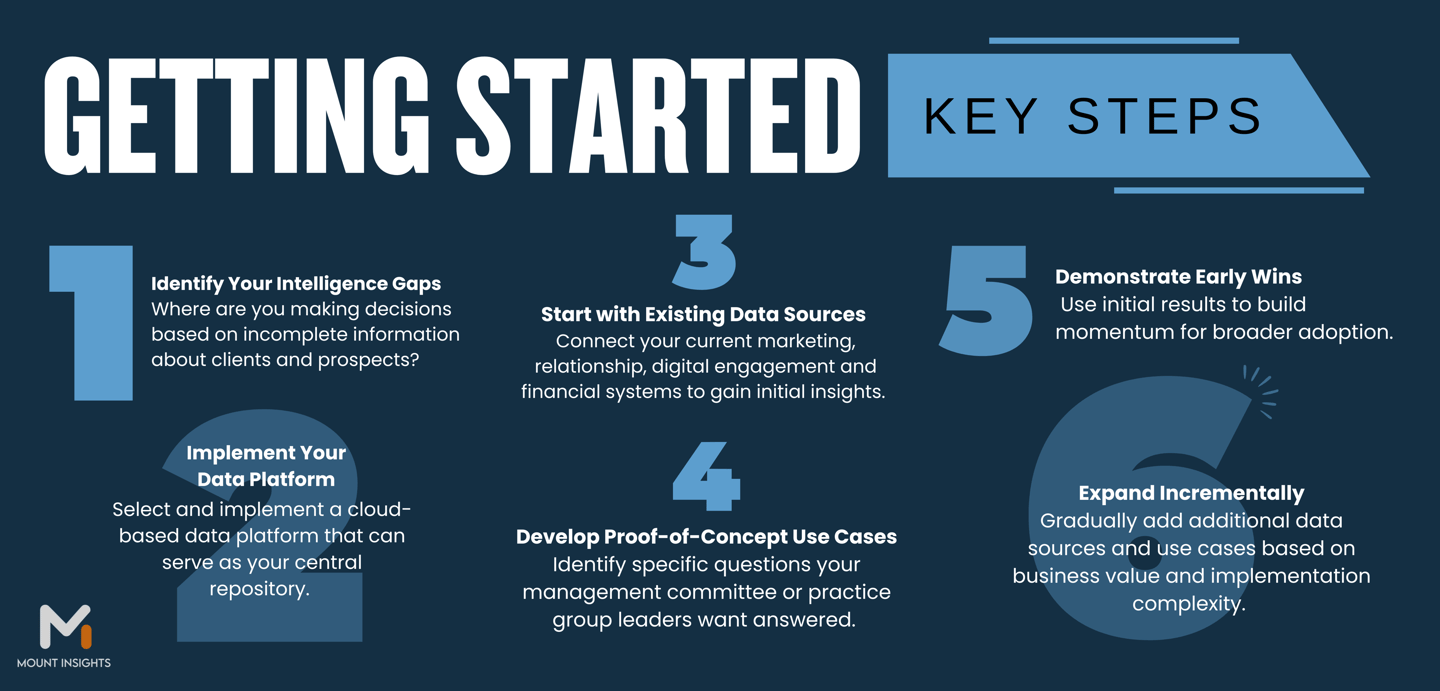
From CRM to Data Strategy: A CMO's Guide to Competitive Advantage in Legal
Djibril Anthony
While many law firms are still considering upgrading to modern CRM systems, the most innovative organizations have already moved to the next evolution: leading with their data. This presents a unique opportunity for legal: a chance to leapfrog an entire technology generation and position for future success.
Where Legal Technology Stands Today
The legal industry has traditionally moved cautiously with technology adoption. Many firms are still using legacy CRM systems that were designed in the early 2000s—systems that offer limited functionality and end up frustrating users. So, there’s a natural impulse to upgrade these out-of-date systems to what's perceived as more "modern" CRM systems, like Salesforce or Dynamics—options that other industries adopted more than a decade ago.
But here's the reality of these systems: they were designed for a world that no longer exists—a world before cloud computing became ubiquitous, before AI transformed analytics capabilities, and before the explosion of data sources that characterize today's business environment. They were built on the assumption that sales teams, marketers, and executives would spend their days living within the CRM interface—treating it as their primary workspace and digital home. While this approach may have been appropriate in the past, it no longer aligns with how professionals actually work today, especially for non-traditional sellers like law firm partners. Today's professionals expect insights and capabilities to meet them where they work, not force them into yet another siloed system. For CMOs focused on growth and client relationships, these systems solve yesterday's problems, not tomorrow's opportunities.
The Strategic Advantage of Leapfrogging
The good news? This technology lag presents late-adopters with an unusual opportunity. Instead of following the same path from legacy CRM to modern CRM to data platforms, law firms can jump directly to the data platform strategy that leading companies across industries are implementing today.
Consider how communications technology evolved in professional settings just a few years ago; many law firms invested heavily in traditional Cisco phone systems and standalone WebEx solutions for meetings and client calls. Then seemingly overnight, platforms like Slack, Zoom and Teams emerged—completely altering how people communicate both internally and externally.
The most innovative firms didn't just upgrade their Cisco phones and then separately enhance their WebEx licenses. Instead, they recognized the paradigm shift and moved directly to integrated communication platforms that unified messaging, calling, video, and document collaboration into a single ecosystem. This leap allowed them to bypass years of incremental improvements and immediately access capabilities their competitors were still years away from implementing.
What an Integrated Data Strategy Means for Firms
At its core, a data platform strategy recognizes a fundamental truth: your firm's data is more valuable than any single application or interface that accesses it. This approach places a centralized data repository at the heart of your technology architecture.
What Is a Data Platform?
A data platform (often called a data lakehouse in technical circles) is a centralized repository that can store, process, and manage all of the data your firm generates or collects. Unlike traditional databases or CRM systems, a modern data platform can handle….
Structured data: Information organized in a predefined format. Think client contact details, matter information, or billing records. This is the type of data traditionally stored in CRM systems.
Unstructured data: Information without a predefined format, including emails, documents, meeting transcripts, and other content that contains valuable relationship intelligence. Legacy systems struggle with this type of data.
Semi-structured data: Information with some organizational properties but not rigid structure, like website interactions, social media engagement, or event attendance data.
Modern data platforms use cloud technologies (like Azure/AWS Databricks, Microsoft Fabric, Data Cloud or Snowflake) that provide the flexibility, security, and scalability needed to manage all these data types effectively.
How does it provide value?
The value of prioritizing a data platform approach manifests in several key areas:
Comprehensive Client Intelligence: By bringing together structured data from your financial systems, unstructured data from documents, and semi-structured data from digital interactions, you create a complete picture of client relationships impossible to achieve in any single application.
AI-Ready Infrastructure: Modern AI applications are optimized to access and consume diverse data types. A data platform approach provides the foundation for implementing predictive analytics, natural language processing, and other AI capabilities that can transform client service.
Interface Flexibility: Different users need different interfaces. Your BD team might need a full-featured CRM, while lawyers might be best served by embedded insights in Outlook or simple mobile dashboards. A data platform approach allows you to provide the right interface to each user group.
Futureproofing: As technologies evolve and new data sources emerge, a data platform can incorporate them without requiring wholesale replacement of your systems.
Real-World Applications for Legal Marketing Leaders
At its core, an integrated data strategy recognizes that your firm's client intelligence is more valuable than any single application. This approach places your firm's collective knowledge at the center of your growth initiatives.
In practical terms, this means:
A Complete Client Picture: Bringing together information from financial systems, lawyer-client communications, and digital interactions to create a 360-degree view of relationships that no single system can provide.
Marketing Intelligence That Lawyers Actually Use: Delivering insights where your attorneys already work—in their email, on their phones, or in practice group meetings—rather than requiring them to log into a separate system.
Measurable Marketing Impact: Connecting marketing activities directly to business development outcomes and client retention, providing clear ROI metrics for your initiatives.
Future-Ready Foundation: As new channels emerge and client expectations evolve, your firm can incorporate them without replacing core systems.
To make this concrete, here are specific capabilities that become possible:
Proactive Relationship Management: Automatically alert relationship partners when communication with key clients drops below normal patterns or sentiment analysis detects potential concerns—before the client calls with a problem.
High-Value Targeting: Identify which events, content, or outreach strategies actually lead to new matters with specific practice groups, allowing for more targeted investment.
Cross-Selling Intelligence: Provide practice groups with predictive insights about which existing clients show markers similar to those who have historically expanded into additional services.
Personalized Client Experiences: Tailor content delivery, event invitations, and relationship development based on individual client preferences and engagement patterns.
Competitive Differentiation: Use aggregated relationship intelligence to identify and protect client relationships during lateral moves and competitive threats.
These capabilities extend far beyond what any CRM alone can deliver, no matter how recently it was implemented.
Starting Your Firm’s Journey
The good news is that implementing a data platform approach doesn't require replacing all your existing systems at once. You can start with a focused application, typically beginning with marketing and business development data, while establishing the foundation for broader integration.
Ready to get started? Check out some tips below...


